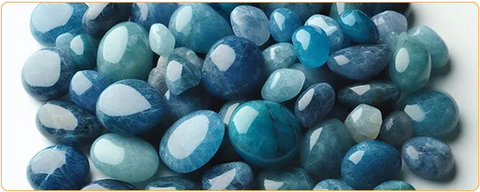Blue apatite properties and virtues

Blue apatite is widely used in the making of mala necklaces or bracelets which are composed of stone beads.
Origin
The word apatite comes from the Greek word "apatan," meaning "to deceive." Indeed, in the past, apatite crystals were often mistaken for various other minerals. The name apatite was given to it by the German mineralogist Abraham Gottlob Werner in 1786. The main places where apatite is found are Madagascar, Russia, Canada, Brazil, and Germany.
Mineralogy
Apatite is the name of a group of phosphate minerals with similar chemical compositions and physical properties. Specimens of excellent clarity and exceptional color are sometimes cut into faceted gemstones. Apatite is a brittle material. It breaks by both fracture and cleavage, but the cleavage is usually indistinct. Hexagonal apatite crystals are occasionally found in igneous and metamorphic rocks. Apatite is usually green, but can be yellow, brown, blue, purple, pink, or colorless. Only the primary colors blue, green, pink, and golden yellow are commonly used. The color of blue apatite can range from light blue or blue-green to a fairly deep, almost navy blue.
See our collection of Apatite Jewelry or Jewelry with Apatite
Properties in crystal healing
This stone focuses on the cohesion of multiple energies. It acts on us physically, emotionally, mentally, and spiritually. Furthermore, it connects us to ourselves on multiple dimensions. Apatite helps us reconnect with our higher self so that all aspects function harmoniously. At the chakra level, it is a powerful general purifier for the physical, mental, and auric fields.

Chakras
Apatite has a strong effect on the throat chakra. It has a stimulating effect that helps enhance verbal communication. Indeed, it eliminates blockages and reduces tension. It helps release stress, difficulties, and feelings of inadequacy in verbal expression. It greatly facilitates public speaking and improves group communication. Also known to stimulate the third eye chakra, this stone increases intuitive abilities and contributes to the development of clairvoyance or psychic visions.
Emotional virtues
Apatite is the essential stone of letting go. It increases motivation, helps overcome self-consciousness and alienation, and thus promotes openness and social ease. It is beneficial for soothing grief and anger, and for reducing irritability and emotional exhaustion. Blue apatite encourages a positive and hopeful attitude. It is a stone of motivation, favoring independence and ambition. It is also a stone of manifestation, increasing the motivation to succeed and achieve goals by developing feelings of self-confidence and optimism. It helps you accept yourself as you are, to see the truth within, because as long as you cannot truly see your authentic self, change cannot occur. It will help you release any feelings of guilt you may be holding onto, and its energy will also boost self-confidence.
Physical virtues
Blue apatite is associated with a healthy diet, believed to suppress hunger and increase metabolic rate. It generally contributes to the healing of all glands, meridians, and organs, and reduces hypertension. If you are looking for support in changing your eating habits, apatite can be your ally in weight loss. It helps control appetite and encourages healthier food choices. It is also an excellent stone for strengthening the immune system. It aids in the healing of bones and teeth, repairs cartilage, and is helpful in treating joint problems, arthritis, and mobility issues. Blue apatite can be used to soothe headaches and help with vertigo or dizziness. It stimulates eyesight and is particularly effective for excessive eye strain or other problems caused by a lack of eye movement.
More information on apatite can be found in Rebelle-Santé magazine.
Disclaimer: The metaphysical and healing properties described above are provided for inspiration and reference purposes only; they are not scientifically proven and should be considered within the context of holistic healing and spiritual practices. We gather this information and these purported properties from writings, books, folk tales, and various other sources. They also depend on the individual's attitude and beliefs. Furthermore, they are not a substitute for diagnosis or treatment by a qualified therapist or physician.

About the author: Elara Vey
Passionate about ancestral traditions and well-being practices, Elara shares her discoveries for Kaosix to help you integrate more harmony and meaning into your daily life.
Discover her journey →

